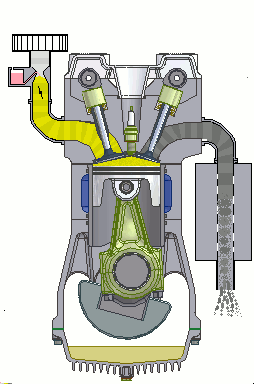
The muscles and sinew of every car is the powertrain. Chief among the various parts of a powertrain is the engine. In the animation above, you can see a single cylinder four stroke engine. If you watch the animation carefully, you can see there are four phases in this engine cycle:
- The cylinder is filled with an air/gas mixture as the piston goes down.
- The cylinder is compressed as the piston goes up.
- The spark plug located at the top of the cylinder fires, igniting the air/gas mixture, forcing the piston down.
- The exhaust fumes are pushed out as the piston goes up.
A car engine is an example of something known as a heat
engine. A heat engine takes heat flow and uses it
to produce work. In the third phase of our example
engine, the spark plug creates a fiery explosion within
the cylinder. This creates a massive burst of
heat. The heat travels away from the cylinder,
creating heat flow. Some of the heat is used to
create mechanical work, creating the power needed to get
your car down the road. The remainder of the heat
is lost through the exhaust system and through your
engine block. A good way to think of this is to
imagine a paddlewheel being driven by moving
water. Your car's engine is a source of water and
a paddlewheel, but instead of creating water, it creates
heat! The maximum possible efficiency, known as
the Carnot efficiency, of your car's engine is governed
by the following equation:
Max Efficiency = [(Th-Tc)/Th]
* 100%
In the equation above, Th is the temperature
of the hot reservoir. In the case of your car
engine, this is the hot gas in the cylinder. Tc
is the temperature of the cold reservoir. In your
car's case, it's the temperature of the outside
air. All temperatures are measured in
Kelvin. At this point, some of the more astute
among you have noticed that you can maximize your
efficiency by increasing the temperature of your hot
reservoir and decreasing the temperature of your cold
reservoir. This is a great idea, but remember that
there are limits to the durability of materials we
create our engines from and not all of us are willing to
live in Antarctica! Further, due to all the moving
parts and the friction between these moving parts, a
real engine will never actually reach the maximum
efficiency. In fact, you'd be lucky if you get 30%
efficiency from your car's engine!
For those of us more interested in the performance
aspect of cars, I present an equation that may excite you.
This is also the only time I will use English
measurement units: